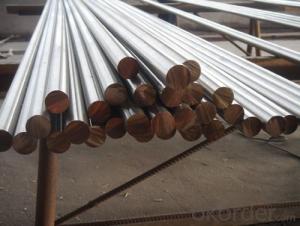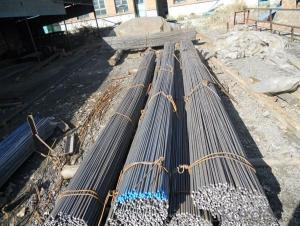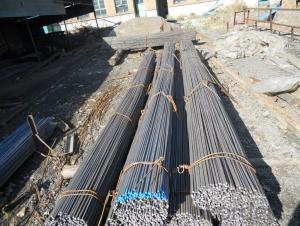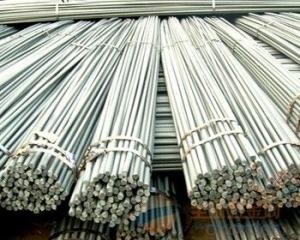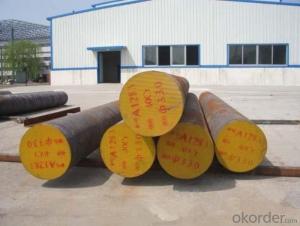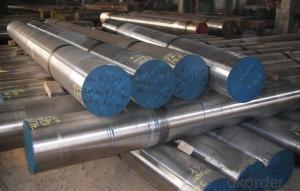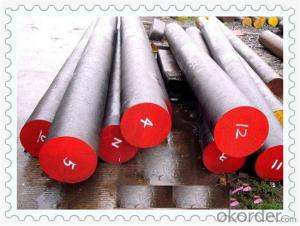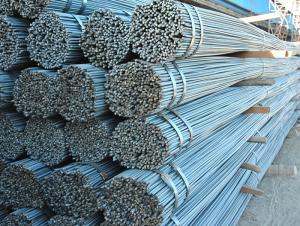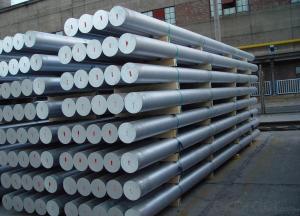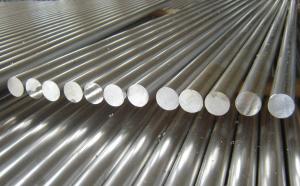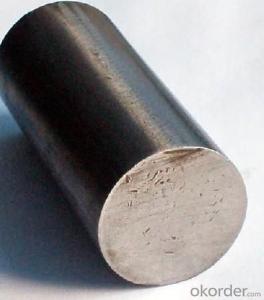Steel Round Bar GB Q235 Q195 5-100MM Hot Rolled High Quality
- Loading Port:
- Shanghai
- Payment Terms:
- TT or LC
- Min Order Qty:
- 25 m.t.
- Supply Capability:
- 20000 m.t./month
OKorder Service Pledge
OKorder Financial Service
You Might Also Like
Product Description:
OKorder is offering high quality Steel Round Bar GB Q235 Q195 5-100MM Hot Rolled High Quality at great prices with worldwide shipping. Our supplier is a world-class manufacturer of steel, with our products utilized the world over. OKorder annually supplies products to European, North American and Asian markets. We provide quotations within 24 hours of receiving an inquiry and guarantee competitive prices.
Product Applications:
1) Suitable for making various strong cutting tool abrasion resistance, impact resistance.
2) Used to produce all kinds of high hard and super hard saw blade, drill, tap, broach, gear hob and various kinds of milling cutter.
3) Used for advanced punching die, screw die, and the toughness and complicated shape of the punch, etc.
4) Is used for cold forging die and drawing mode, etc.
5) Recommended watchcase factory, screw factory and other cold stamping products industry use.
Product Advantages:
OKorder's Steel Round Bar GB Q235 Q195 5-100MM Hot Rolled High Quality are durable, strong, and resist corrosion.
Main Product Features:
· Premium quality
· Prompt delivery & seaworthy packing (30 days after receiving deposit)
· Corrosion resistance
· Can be recycled and reused
· Mill test certification
· Professional Service
· Competitive pricing
Product Specifications:
1. Grade: GB, JIS, ASTM, EN
2. Grade: Q235, SS400, A36, S235JR
3. Diameter and mass: As below
Diameter | Mass | Diameter | Mass | Diameter | Mass |
(mm) | (kg/m) | (mm) | (kg/m) | (mm) | (kg/m) |
6 | 0.22 | 22 | 2.98 | 53 | 17.30 |
7 | 0.30 | 24 | 3.55 | 56 | 19.30 |
8 | 0.40 | 25 | 3.85 | 60 | 22.20 |
9 | 0.50 | 26 | 4.17 | 63 | 24.50 |
10 | 0.62 | 28 | 4.83 | 65 | 26.00 |
11 | 0.75 | 30 | 5.55 | 70 | 30.20 |
12 | 0.89 | 32 | 6.31 | 75 | 34.70 |
13 | 1.04 | 34 | 7.13 | 80 | 39.50 |
14 | 1.21 | 36 | 7.99 | 85 | 44.50 |
15 | 1.39 | 38 | 8.90 | 90 | 49.90 |
16 | 1.58 | 40 | 9.86 | 95 | 55.60 |
17 | 1.78 | 42 | 10.90 | 100 | 61.70 |
18 | 2.00 | 45 | 12.50 | 120 | 88.85 |
19 | 2.23 | 48 | 14.20 | 140 | 120.93 |
20 | 2.47 | 50 | 15.40 | 150 | 138.82 |
4. Material: Mild Steel
5. Heat treatment of high quality steel:
Fire: Isothermal annealing temperature is 800 ~ 880 °C, with 10 ~ 20 °C, the furnace cooling to about 600 °C, hardness above HB269.
Preheat temperature: 730-730 °C
Quenching temperature: 1190-1210 °C
Tempering temperature: 540-595 °C
Cold drawn, hardness 285 HBS
Cold drawn after annealing condition, hardness 277 HBS
Quenching methods: oil quenching, air cooling or salt bath quenching
FAQ:
Q1: Why buy Materials & Equipment from OKorder.com?
A1: All products offered byOKorder.com are carefully selected from China's most reliable manufacturing enterprises. Through its ISO certifications, OKorder.com adheres to the highest standards and a commitment to supply chain safety and customer satisfaction.
Q2: What makes stainless steel stainless?
A2: Stainless steel must contain at least 10.5 % chromium. It is this element that reacts with the oxygen in the air to form a complex chrome-oxide surface layer that is invisible but strong enough to prevent further oxygen from "staining" (rusting) the surface. Higher levels of chromium and the addition of other alloying elements such as nickel and molybdenum enhance this surface layer and improve the corrosion resistance of the stainless material.
Q3: Can stainless steel rust?
A3: Stainless does not "rust" as you think of regular steel rusting with a red oxide on the surface that flakes off. If you see red rust it is probably due to some iron particles that have contaminated the surface of the stainless steel and it is these iron particles that are rusting. Look at the source of the rusting and see if you can remove it from the surface.
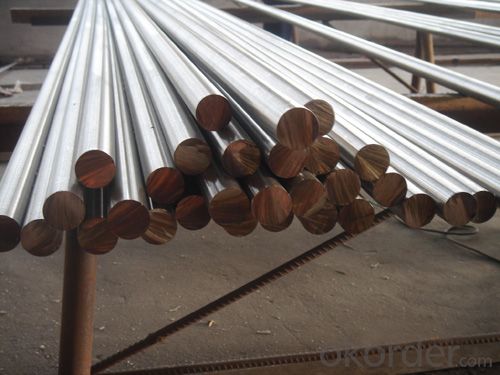

- Q: Can steel round bars be used for making connecting rods?
- Yes, steel round bars can be used for making connecting rods. Steel is a commonly used material for connecting rods due to its high strength and durability, making it suitable for withstanding the stress and load requirements of an engine.
- Q: Can steel round bars be used for making universal joints?
- Yes, steel round bars can be used for making universal joints. Steel round bars are commonly used in the manufacturing of universal joints due to their strength, durability, and ability to handle high torque and rotational forces.
- Q: What is the difference between a hot-rolled and a cold-drawn steel round bar?
- The main difference between a hot-rolled and a cold-drawn steel round bar lies in the manufacturing process and the resulting properties of the finished product. Hot-rolled steel round bars are produced by heating a billet or ingot at a high temperature, typically around 1100 to 1300 degrees Celsius, and then rolling it into the desired shape and size. This process results in a rougher surface finish and larger tolerances compared to cold-drawn bars. Hot-rolled bars are generally less precise in dimensions and may have some surface defects such as scale or rust. On the other hand, cold-drawn steel round bars are manufactured by pulling a hot-rolled bar through a die at room temperature. This process reduces the diameter and enhances the surface finish of the bar, resulting in a smoother and more precise product. Cold-drawing also improves the mechanical properties of the steel, such as increased strength, hardness, and improved surface quality. The cold-drawing process also provides closer dimensional tolerances, making cold-drawn bars suitable for applications that require higher precision. In summary, the difference between a hot-rolled and a cold-drawn steel round bar lies in the manufacturing process, resulting in different surface finish, dimensional tolerances, and mechanical properties. Hot-rolled bars are produced at high temperatures, have a rougher surface, and larger tolerances, while cold-drawn bars are manufactured at room temperature, have a smoother surface, closer dimensional tolerances, and enhanced mechanical properties. The choice between the two depends on specific application requirements and the desired characteristics of the finished product.
- Q: How do you determine the strength of a steel round bar?
- The strength of a steel round bar can be determined through various methods, but the most common approach is by conducting a tensile test. This test involves applying a controlled force to the bar until it fractures, allowing for the measurement of its ultimate tensile strength (UTS). Other important parameters, such as yield strength, elongation, and reduction in area, can also be determined from the test results. Additionally, the chemical composition and microstructure of the steel can provide valuable insights into its overall strength and performance characteristics.
- Q: Are steel round bars suitable for structural applications?
- Indeed, steel round bars are well-suited for structural applications. Renowned for their robustness and resilience, steel round bars prove to be excellent for diverse structural purposes. They exhibit exceptional load-bearing capabilities, thus frequently employed in construction undertakings like bridges, buildings, and infrastructure projects. Moreover, steel round bars possess commendable resistance against corrosion, fire, and severe weather conditions, thereby ensuring the longevity and structural integrity of the application. Their adaptability allows for effortless shaping, welding, and customization to satisfy the project's specific requisites. All in all, steel round bars present themselves as a dependable and cost-efficient option for structural applications.
- Q: What is the minimum tensile strength of steel round bars?
- The minimum tensile strength of steel round bars can vary depending on the specific grade of steel being used. However, in general, most steel round bars have a minimum tensile strength of around 400 megapascals (MPa) or 58,000 pounds per square inch (psi). It is important to note that this is a baseline minimum and different grades of steel may have higher tensile strengths to suit specific applications or requirements.
- Q: What are the different types of steel round bars used in the automotive steering systems?
- There are several types of steel round bars used in automotive steering systems, including carbon steel, alloy steel, and stainless steel. Carbon steel round bars are commonly used due to their affordability and high strength properties. Alloy steel round bars are used when higher strength and durability are required, as they have additional alloying elements such as chromium, nickel, and molybdenum. Stainless steel round bars are preferred for their corrosion resistance properties, making them suitable for steering components exposed to harsh environments or moisture.
- Q: Can steel round bars be used in the food processing industry?
- Steel round bars can indeed be utilized in the food processing sector. Steel is widely applied across various industries owing to its robustness, longevity, and ability to resist corrosion. In the realm of food processing, steel round bars find frequent application in equipment like food mixers, conveyors, and cutting tools. These bars are typically crafted from stainless steel, a specific steel variant enriched with chromium and other elements to enhance its resistance against corrosion and staining. Remarkably, stainless steel is non-reactive and does not introduce any flavors or odors into the processed food. Additionally, it is effortless to clean and maintain, rendering it highly suitable for deployment in food processing facilities where hygiene is paramount. However, it is crucial to ensure that the steel round bars employed in the food processing industry adhere to the necessary standards and regulations to guarantee the safety of the processed food.
- Q: What is the difference between a ground and a polished steel round bar?
- A ground steel round bar refers to a bar that has undergone a grinding process to achieve a smooth and precise outer surface. On the other hand, a polished steel round bar refers to a bar that has been polished to enhance its appearance, often resulting in a shiny and reflective surface. While both processes improve the surface quality of the bar, grinding focuses on accuracy and removing imperfections, while polishing is primarily done for aesthetic purposes.
- Q: Are steel round bars suitable for use in the construction of bridges?
- Indeed, steel round bars prove to be a suitable choice for the construction of bridges. Offering a multitude of advantages, they are an ideal option for such projects. To begin with, steel round bars exhibit remarkable tensile strength, enabling them to withstand substantial loads and forces without undergoing deformation or breakage. This attribute holds paramount importance for bridges, as they bear the weight of vehicles and pedestrians. By possessing high tensile strength, steel round bars ensure the structural integrity and safety of the bridge. Furthermore, steel round bars boast exceptional durability and resistance to corrosion. Considering the exposure of bridges to adverse environmental conditions like rain, snow, and saltwater, materials employed in their construction are susceptible to corrosion and deterioration. However, steel round bars are specifically designed to counteract these effects, guaranteeing the longevity and dependability of the bridge. Moreover, steel round bars are widely available in various sizes and lengths, catering to the versatility and adaptability required for different bridge designs and configurations. The uniform circular shape of these bars simplifies the construction process, enabling easy cutting, bending, and welding to meet the necessary specifications. In addition, steel round bars offer cost-effectiveness in bridge construction. Their favorable strength-to-weight ratio allows them to provide the required strength while minimizing the overall weight of the bridge. Consequently, this reduces the amount of material needed and lowers transportation costs during construction. In conclusion, steel round bars are highly suitable for bridge construction due to their high tensile strength, durability, corrosion resistance, versatility, and cost-effectiveness. They deliver the necessary strength and reliability to support heavy loads and withstand adverse environmental conditions, ensuring the safety and durability of the bridge.
Send your message to us
Steel Round Bar GB Q235 Q195 5-100MM Hot Rolled High Quality
- Loading Port:
- Shanghai
- Payment Terms:
- TT or LC
- Min Order Qty:
- 25 m.t.
- Supply Capability:
- 20000 m.t./month
OKorder Service Pledge
OKorder Financial Service
Similar products
Hot products
Hot Searches
Related keywords
